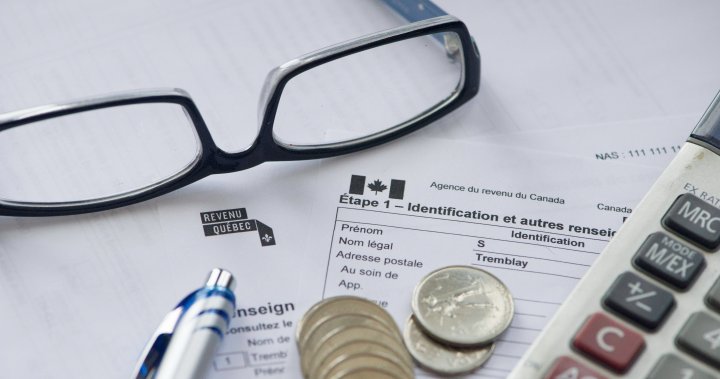The 2024 tax filing season comes with a few key changes for Canadians who work from home, sold a home or are saving to buy their first one.
Here are some of the significant changes to tax credits and deductions to be aware of, as well as the key dates to know for individuals and business owners.
Feb. 19 marks the first day the Canada Revenue Agency opens its portal to file for 2023 income taxes; and reminder, in the months ahead you’ll be filing for last year’s earnings as well as any deductions and contributions that will affect taxable income that year.
Individual Canadians have until April 30 to file their income taxes with the CRA.
For those who run their own business or who have a self-employed spouse, that deadline stretches to June 17 this year – delayed two days because the usual June 15 date falls on a Saturday.
But keep in mind that if you owe money to the CRA on your 2023 taxes, the deadline to pay that amount still falls on the earlier April 30 date, regardless of your employment status.
Jamie Golombek, managing director of tax and estate planning at CIBC Private Wealth, says one “pretty big change” that certain tax filers should be aware of this season is the end of the simplified method for claiming expenses related to working from home.
For the past three tax years amid the COVID-19 pandemic, Canadians working remotely have been allowed to claim expenses in two ways, one of which was a temporary, simplified method that gave a flat $2 per day working from home to a maximum of $500. That’s been eliminated for the 2023 tax year.
Instead, anyone who works mainly from home – more than half of their working days – will need to file using the detailed method. This route also requires a signed T2200 form from your employer attesting that you primarily work from home.
Golombek explains this means diligently tracking expenses and performing a few calculations based on your working space and time spent at home. The CRA has a tool to help break down these calculations and determine eligibility to claim working-from-home expenses.
While every dollar claimed on office supplies like pens, paper and printer ink is a dollar of taxable income saved, Golombek notes that not every remote worker might feel like the time needed to go through the detailed method is worth it.
Get the latest Money 123 news.
Sent to your email, every week.
While a portion of utilities like home internet, electricity and heating can be claimed, there can be big differences based on whether someone owns their own home. Rent can be claimed as a significant cost for remote workers, but Golombek notes that mortgage interest costs are not eligible, making the claim less substantial for homeowners. Commission employees can claim their property taxes and home insurance, however.
While he says it’s a method he uses for his own taxes each year, Golombek also knows collecting a year’s worth of bills and other itemized receipts can be a chore.
“When I used the detailed method, I had to go in there and get all 12 utility bills from electricity, from natural gas and from my internet provider, one by one, download them all, add them all up, prorate it,” he says. “It was worth it for me, but it’s not going to be worth it for everyone.”
Some Canadians with a quick turnaround on a home sale might want to be aware of new changes for the 2023 tax year aimed at cracking down on house flippers.
Normally when an individual sells their own home, they can claim a primary residence exemption to avoid paying taxes on the transaction.
The Liberal government introduced a change that came into effect in 2023 targeting home flippers who moved in, quickly renovated or sat on a house that appreciated in value, and sold it as a source of income but skirted the business taxes thanks to the exemption.
Now, anyone who sells their principal residence within 12 months of taking possession may not claim the principal residence exemption and will have to pay full business taxes on the proceeds of the sale.
Golombek expects this will likely not be a “big issue” for most Canadians, noting that there are still numerous exceptions to this new rule for certain life events like a divorce, death or disability that might force a move earlier than planned.
“But for someone who does sell their home within 12 months, it’s something to be careful about,” he says.
Homeowners who did a renovation in 2023 to develop a secondary unit for a senior or family member with a disability can also qualify for a new tax credit introduced last year.
The multigenerational home renovation tax credit allows individuals to claim up to $50,000 in qualifying expenses for a project. The tax credit will return 15 per cent of eligible costs, up to $7,500, for a project. Regular maintenance, new appliances and gardening expenses are among those that would not be covered by the new credit.
Some young Canadians saving for a home might get their first brush with income tax deductions this filing season. That’s thanks to the first home savings account (FHSA) introduced in 2023.
The FHSA allows individuals to contribute up to $8,000 annually into a tax-free savings account, up to a maximum of $40,000, toward the down payment of a first home.
FHSA funds are not taxed at withdrawal, and are also tax deductible on the way in – just like a registered retirement savings plan (RRSP). For anyone who opened and contributed to an FHSA in 2023, that amount is taken off an individual’s taxable income for last year.
Canadians who contributed to an FHSA should expect a tax slip from their financial institution with details for the claim on their 2023 income taxes, Golombek says.
Since unused contribution room rolls over year to year, he notes it’s also a “great time” for individuals who didn’t reach the $8,000 maximum deposit in 2023 to top up those amounts. Contributions made toward the FHSA now will count towards 2024 income taxes, however, as the deadline for the 2023 filing passed at the end of last year.
For Canadians getting an early start on filing in February who want to reduce their 2023 taxable income further, there’s still time to make an RRSP contribution to count toward last year’s taxes. The deadline for RRSP contributions this year is Feb. 29.
While it can be exciting to see a big tax return at the end of the filing process, particularly for younger Canadians who have never made significant RRSP contributions, Golombek says this can actually be a symptom of “poor tax planning.”
When an individual receives a major tax return in the realm of thousands of dollars, it essentially means they’ve overpaid their taxes for the preceding year. While the CRA returns this money after all the deductions and credits are recorded, Golombek notes this money has essentially been on loan to the government for a year – interest-free.
Instead, Canadians can fill out a T1213 form to list all their applicable deductions to have them taken off at the source by an employer. RRSP and FHSA contributions, child-care expenses, large charitable donations and more can all be applied up front this way.
By doing this, an employer will take less in taxes off each pay, giving Canadians the tax return they would’ve gotten upfront instead of in bulk during tax season the following year.
You can therefore make that money work for you immediately by paying down debt or investing, rather than waiting until next year to take advantage, Golombek says.
“You’re actually reaping those rewards throughout the entire year, instead of waiting for that psychological reward the following year,” he says.




